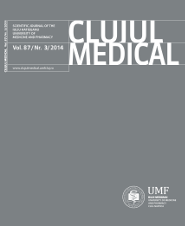THE VALUE OF INDUCED SPUTUM IN THE DIAGNOSIS AND MANAGEMENT OF CHILDREN WITH BRONCHIAL ASTHMA
DOI:
https://doi.org/10.15386/cjmed-284Keywords:
Induced sputum – Child – Bronchial asthma – Eosinophil – InflammationAbstract
Background: Induced sputum in children with bronchial asthma represents a non-invasive method of bronchial inflammation assessment. The main objective of our study was to analyze the cellularity of sputum in patients with bronchial asthma according to the level of disease control and the controlling therapy (with/without inhaled glucocorticoids). The second objective was to establish the correlation between sputum cellularity and other indirect parameters used to evidence bronchial inflammation (exhaled nitric oxide) and obstruction (forced expiratory volume in 1 second).
Methods: The study included children with bronchial asthma that were assessed clinically (physical exam, questionnaire on the control of bronchial asthma in children) and by medical tests (induced sputum, exhaled nitric oxide, spirometry).
Results: In patients with partially controlled asthma and those with uncontrolled asthma, the eosinophils percentage in the sputum was higher than in patients with controlled asthma (19.8±26.4% respectively 9.2±20.5% versus 4.5±14.6%, p<0.001). Higher percentage of neutrophils in the sputum was found in the partially controlled and uncontrolled asthma than in the controlled asthma (43.9±20.1% respectively 51.6±38.3% versus 35±19.7%, p=0.009). We also evidenced a direct and statistically significant correlation between the exhaled nitric oxide and the neutrophils percentage in the sputum (r=0.67, p=0.0003). Also, an indirect, moderate to good correlation (r=-0.56, p=0.005) was evidenced between the values of the forced expiratory volume in 1 second and the high eosinophils percentage in the sputum.
Conclusions: In partially controlled and uncontrolled bronchial asthma the eosinophils and neutrophils count in the sputum is significantly higher than in patients with controlled asthma. There is an indirect correlation between the high eosinophils count in the sputum and the forced expiratory volume in 1 second, as well as a direct correlation between the neutrophils count and the exhaled nitric oxide, suggesting that induced sputum should be used in combination with other indirect parameters for the evidence of bronchial inflammation.
Downloads
Published
How to Cite
Issue
Section
License
The authors are required to transfer the copyright of the published paper to the journal. This is done by agreeing to sign the Copyright Assignment Form. Whenever the case, authors are also required to send permissions to reproduce material (such as illustrations) from the copyright holder.

The papers published in the journal are licensed under a Creative Commons Attribution-NonCommercial-NoDerivatives 4.0 International License.

